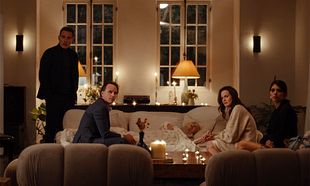June and Jennifer Gibbons (Letitia Wright, Tamara Lawrance) have a deeply shared life together as twins, filled with their inner worlds and imaginations. However, as they grow more insular and fall under bad influences, they are eventually sent to an oppressive mental hospital where they begin to deteriorate at an alarming rate, all the while trying to reconnect with one another and learn to exist in the outside world...
The term 'outsider art' is normally referred to as works of art - be it writing, painting, music - that has a certain amount of naivete attached to it, and is made without the formal understanding or education of the precepts of the chosen artform. In other words, it's self-taught painting and music, not fitting into any given conventions or structures. Seeing as how 'The Silent Twins' follows two young women who are considered in literary circles as "outsider writers", it makes sense that the movie about their lives has an equally strange, formless setting.
'The Silent Twins' frequently pauses its story in order to fly into a dreamlike world of the protagonists' imagination. A huge dance sequence is set inside a gloriously colourful world where the twins are signing autographs as synchronised swimmers dance and bob around them. The lead-up to this is they've been sentenced to a mental hospital, with one of them imagining it as a wonderful place. The reality that follows afterwards crushes them of this imagination, and their creative spirit is soon hollowed out of them both. Arthouse movies have that freedom to throw pacing and structure out the window, instead opting for atmosphere, feeling, and ambiguity to fill up the space.
Both Letitia Wright and Tamara Lawrance give fully committed performances, both of them warping and dancing around one another to the point where they're essentially two halves of the same person. Neither one of them gains an upper hand, because it's not that kind of competition. If anything, their dynamic collapses when they go against each other. Yet, their descent into madness isn't necessarily given a satisfactory explanation. It simply pins their problems on Jack Bandeira's character, who looks and sounds like every asshole American jock character out there. This may be on purpose, that both his and every other character outside of the twins are tropes rather than fully realised people, and that they themselves cannot connect with anyone beyond this.
While that's an intriguing concept and idea, it does stretch the patience and makes it difficult to connect with any of the characters beyond them. Agnieszka Smoczyńska, in her first English language effort as director, has a firm grip on visuals and setting. There are such gorgeous shots in this, both in the starkness of the hospital where the second half of the movie is set, but also in the dream scenes where it's all about vibrancy and contrasting colours. Again, like a lot of arthouse movies, it's more about the experience and the viewing than it is about the story and the structure of it all.



















































































